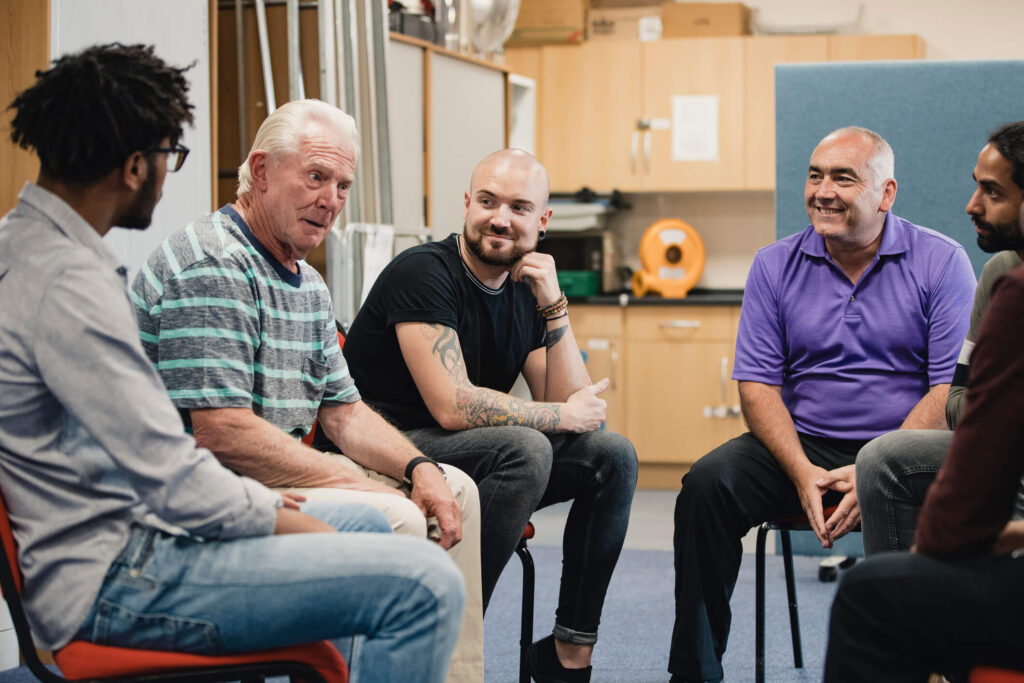Toolkit for people who have been impacted by a suicide loss
The Mental Health Commission of Canada, in collaboration with the Canadian Association for Suicide Prevention, the Canadian Mental Health Association, Alberta Division (CMHA Alberta) and Centre for Suicide Prevention, the Public Health Agency of Canada, along with an Advisory Committee comprised of people with lived experience related to suicide, have developed toolkits to support people who have been impacted by suicide. This toolkit focuses on resources for people who have lost someone to suicide; a companion toolkit is tailored for people who have been impacted by a suicide attempt.
The content of the toolkits is informed by an online survey we did in the summer of 2017 to gather feedback from people affected by suicide. There were over 1,000 responses, and the feedback helped us develop a better understanding of what topics, content areas, resources, and information were important to include in the toolkits. Please note that the toolkits are not an exhaustive list of the wide variety of resources available across Canada for support. If you are not finding the tools and resources that resonate most with you, you may wish to connect with a trained responder by contacting 988.

Introduction

The Content
There is no right or wrong way to seek help. This toolkit is not designed to be an exhaustive list of the very wide variety of resources available across Canada for support. It is intended to be a summary of the tools that have resonated most with the hundreds of people who completed an online survey we conducted and of resources from a literature review completed by the Canadian Mental Health Association, Alberta Division (CMHA Alberta) and Centre for Suicide Prevention.
If you are not finding the tools and resources that resonate most with you, you may consider talking with someone. You may wish to connect with a trained responder by contacting 988 or Kids Help Phone.
What it is
This toolkit focuses on resources for people who have lost someone to suicide; a companion toolkit is tailored for people who have been impacted by a suicide attempt.
The content of the toolkits is informed by an online survey we did in the summer of 2017 to gather feedback from people affected by suicide. There were over 1,000 responses, and the feedback helped us develop a better understanding of what topics, content areas, resources, and information were important to include in the toolkits. The toolkits also include resources highlighted in a literature review done by the CMHA Alberta and Centre for Suicide Prevention. Both toolkits were refreshed in 2025 to reflect updated resources.
Language
Survey respondents indicated a preference for “people-first” language. You may consider yourself to be someone who has experienced a suicide loss, or you may identify yourself as a survivor of a suicide loss. How you identify yourself is a personal decision.
Strategies and coping suggestions
There is no single way or “right” way to cope with a death by suicide. Whether you are a colleague, friend, neighbour, or family member, everyone’s relationship with the person who has died is unique. This means the loss will affect people differently, and each person will have their own unique way of dealing with the loss.
Below is a non-exhaustive list of strategies you can use as you grieve. If you are not finding the tools and resources that resonate most with you, you could try talking about your options with a trained responder by contacting 988.
Navigating suicide loss: resources, stories, and support for healing
It’s normal to grieve the death of someone you know. Suicide grief is unique. It can be a far more intense and complicated experience than other types of loss.

About suicide grief
Many suggest that bereavement after a suicide is unlike any other kind of bereavement. As the National Action Alliance for Suicide Prevention states, “suicide bereavement is unique because suicide itself is a singular manner of death.”1 The grieving process is further complicated by the inexplicable nature of suicide itself. Add notions of guilt and the pressures of stigma, and there is a potential risk for suicide for anyone experiencing complicated grief due to suicid
Reactions to a suicide loss will be different for every person. Some of these reactions may include:
- shock and numbness
- deep sadness
- anger and blame
- guilt
- shame
- relief
- deniale
- why questions
- fear
- depression
- leaning on spiritual or religious beliefs
- thinking about suicide
- reaching out
To learn more about the reactions to suicide loss, refer to Normal Reactions to Suicide Loss by the Canadian Association for Suicide Prevention.
- What is Suicide Bereavement by the Crisis Centre of BC is an informational video to support those who have experienced suicide loss.
- Grieving by the Canadian Mental Health Association (CMHA) describes what grief is, how to manage it, and how to help a loved one.
- Suicide grief and loss by the CMHA Alberta and Centre for Suicide Prevention compares suicide grief and grief following other losses
- Survivors of Suicide Loss by the Lifeline Canada Foundation guides readers through the difficult time after a suicide loss.
- The Bereaved by suicide website by Lifeline Australia offers tips and advice to people bereaved by suicide.
- Expert Untangles Complexities of Grief for Suicide Loss Survivors, an article published by the University of Colorado Anschutz Medical Campus, discusses how to embrace community and stay connected after a suicide loss.
- Complicated Grief by the Cleveland Clinic explains how complicated grief differs from normal grief.

Grief and suicide resources for children and youth
These resources include ones that discuss how to support a young person after a suicide loss, and resources for children and youth
themselves.
- Supporting Children and Youth to Grieve after Suicide Loss by the CMHA PEI Division
- Supporting Children and Teens after a Suicide Death by the Alliance of Hope
- The Canadian Alliance for Children’s Grief’s child and youth bereavement support groups across Canada
- Communicating with suicide bereaved children by Support After Suicide
- Talking to Children About a Suicide by the Mental Health Commission of Canada (MHCC)
- Goodnight Mr. Vincent van Gogh by Lindsey Doolittle (children’s book)
- Red Chocolate for Elephants: For Children Bereaved by Suicide by Diana Sands (children’s book)
Stories from people with lived experience
These websites and blogs feature the voices of people who have lost someone to suicide.
- 8 Ways to Cope After a Suicide Loss by the Tragedy Assistance Program for Survivors
- Left behind after suicide by Harvard Health Publishing
- 20 Messages for Suicide Loss Survivors During the Holidays by Sarah Schuster from The Mighty
- A Letter to Parents Surviving a Child’s Suicide by Sam Fiorella from The Friendship Bench
- International Survivors of Suicide Loss Day documentaries by the American Foundation for Suicide Prevention
- Our Side of Suicide, a website with many articles and blogs about coping strategies
- A Handbook for Coping with Suicide Grief by the American Association of Suicidology, a booklet that offers insight and essential information covering common experiences by people impacted by suicide loss.

Peer support groups
Peer support can be an invaluable source of strength for people who have been impacted by a suicide attempt. Peers can provide emotional support that helps address suicide risk as they share their own experience of recovery, thereby fostering perceived connectedness and reducing feelings of hopelessness among those receiving support — two key factors that protect against suicidal ideation.2
- Peer Support Canada serves as the national voice for peer support.
- Peer support in suicide prevention by the Canadian Mental Health Association, Alberta Division (CMHA Alberta) and Centre for Suicide Prevention discusses the role of peer support in preventing suicide.
- The Canadian Association for Suicide Prevention provides a Support Services Directory to help find a survivor support centre in Canada.
- The American Foundation for Suicide Prevention offers a directory (Find a Support Group) of both Canadian and American support groups for people who have lost someone to suicide.
- Alliance of Hope for suicide loss survivors is an online support forum for people who have lost someone to suicide.
- Find self-help, mutual aid, and support groups across Canada here.
- Suicide bereavement support groups: A guide by the CMHA Alberta and Centre for Suicide Prevention and the Canadian Association for Suicide Prevention provides a set of guidelines and recommendations to create and sustain a suicide bereavement support group.
Counselling and therapy
Finding the right counsellor may take time. It may also take time to find the therapy and therapist that best suit you. As a starting point, you may want to start a conversation with your family physician. Your doctor may be able to discuss with you whether you require medication in the short term and may also be able to recommend a good counsellor for you. Give yourself the time and permission to look for a therapist whom you feel hears you, understands you, believes you, and provides a type of therapy that works well for you.
- Finding the right psychologist can be difficult. On its web page Finding the Psychologist for You, the Canadian Psychological Association maintains a list of all the provincial and territorial associations of psychology.
- You may find a good counsellor or therapist using the Find a Therapist directory provided by Psychology Today.
- Other resources for finding counselling include the following:
- Inclusive Therapists maintains a searchable database of therapists.
- Healing in Colour envisions a world where Black, Indigenous, and people of colour, in all intersections, have access to therapy that supports healing and liberation.
- The Affordable Therapy Network is a directory of therapists offering low-cost and sliding-scale counselling across Canada.

In the same way that not all therapists will be a good fit for everyone, not all types of therapy will suit everyone well. Counsellors may use cognitive behavioural therapy (CBT), dialectical behaviour therapy (DBT), narrative therapy, motivational interviewing, and other techniques, depending on your needs. You can learn about different types of therapy techniques here.
Other resource
- In Writing the Obituary: Where to Start, Alliance of Hope shares suggestions on how to write an obituary for someone who has died by suicide.
How to support a loved one who is having thoughts of suicide
If you are a friend, family member, acquaintance, or colleague of someone who has lost a loved one to suicide, it can be hard to know what to
say and how to support that person; however, it is important to support them to help prevent them from feeling isolated and alone.

Postvention
People who have been affected by a suicide loss need help to work through their grief, whether at school, at work, or in the community.
- The What to do after a suicide webinar by the CMHA Alberta and Centre for Suicide Prevention walks teachers through what to do after a student in the school has died by suicide.
- After a Suicide: A Toolkit for Schools by the American Foundation for Suicide Prevention, the Suicide Prevention Resource Center, and the Education Development Center acknowledges that a school community can be deeply affected by a student suicide.
- A Manager’s Guide to Suicide Postvention in the Workplace by the American Association of Suicidology and the National Action Alliance for Suicide Prevention examines how to respond when a suicide occurs in a workplace.
- In Responding to suicide risk in the workplace: A guide for people professionals the Chartered Institute of Personnel and Development provides practical guidance on educating the workforce about suicide and opening up the workplace culture to talk about it.
- Suicide Postvention Resources for Canadian Communities by the MHCC is a catalogue of postvention resources.
- Postvention across settings and sectors: A resource for community-based service providers was prepared by the Ontario Youth Suicide Prevention Life Promotion Collaborative as a guide for community- and education-based providers.
Risk of suicidality for family and friends of an attempt survivor or someone who died by suicide
There is always a potential risk that vulnerable family members or friends who have been exposed to a suicide attempt or a death by suicide
may develop thoughts of suicide themselves.
- In Preventing Suicide, the CMHA Toronto provides tips on how to talk to a family member or friend who may be contemplating
suicide. - Sample script on how to talk to someone who may be having thoughts of suicide:
“It sounds like things are really hard for you right now. I can’t imagine what you’re going through, but I know things will get better! Let’s text the distress centre to see what resources they might have that could help. I’m so glad you told me how you’re feeling; I’ve been really worried about you! I feel like it’s a good idea to talk to your parents, too. Want me to come with you?”3
Suggested readings:
- An article entitled “Familial Transmission of Suicidal Behaviour” looks at the effects that exposure to suicidal behaviours can have on family members.4
- The Continuum of “survivorship”: Definitional Issues in the Aftermath of Suicide” is a paper that looks at the impact that suicide has on survivors.5
Crisis lines and coping tools
When you are dealing with the shock and aftermath of losing someone to suicide, situations can arise that may increase your level of distress. Don’t expect to be able to manage this distress on your own — support is available. Keep the following list of resources on your phone or on a piece of paper in your wallet to ensure they are accessible when you need them most. You may also share them with a friend who can remind you of them.
Crisis lines
- 988 Suicide Crisis Helpline: a nation-wide crisis line available to call or text 24/7 (988)
- Kids Help Phone: a 24-hour, bilingual phone, web, and referral service for children and youth (1-800-668-6868)
- Hope for Wellness Helpline: a helpline for Indigenous People (1-855-242-3310)
- Canadian Forces Morale and Welfare Services’ family information line: an information and crisis line for the military community (1-800-866-4546)
- Boots on the Ground: Peer Support for First Responders (1-833-677-2668)
- It Gets Better Canada: a list of crisis lines in Canada for sexual, gender, and racial minorities
Contacting a crisis line
- The 9-8-8 Suicide Crisis Helpline has a web page describing what to expect when you call or text 988.
- The CMHA Alberta and Centre for Suicide Prevention offers advice on how to ask for help if you are having thoughts of suicide.
- Suggested scripts for talking to a helpline:6
- “Hi. I am calling because I need some help. I’m going through some things that are tough and it sometimes feels like I can’t take it anymore. It’s so bad there are times I think about suicide.”
- “Hi. Things are really hard right now. I’m thinking about killing myself.”
- Suggested scripts for texting a helpline:6
- “I need help. My life is bad right now and I’m thinking about suicide.”
- “I’ve been thinking about killing myself. Can you help me?”
Developing a safety plan
- Safety plans to prevent suicide is a toolkit by the CMHA Alberta and Centre for Suicide Prevention.
- Things to Consider When Creating a Safety Plan is a resource by the National Suicide Prevention Lifeline.
- How to make a suicide safety plan was developed by SuicideLine Victoria (Australia).
- Sunnybrook Health Sciences Centre’s Coping card is a practical tool that can help a person make an action plan to cope effectively with
an emotional crisis so that they do not engage in suicidal behaviour. - Safety Planning Intervention: A Brief Intervention to Mitigate Suicide Risk describes an innovative way to reduce suicide risk.
- Wellness Recovery Action Plan (WRAP) Personal Workbook is a tool to develop an effective approach to overcoming distressing symptoms and unhelpful behaviour patterns.
Coping strategies for people with thoughts of suicide
- Coping with Suicidal Thoughts by Joti Samra and Dan Bilsker addresses how to cope with thoughts of suicide and other means of keeping yourself safe.
- How I can cope with thoughts of suicide by Kids Help Phone facilitates the conversation around reaching out for help.
Telling your story safely
Telling your story can be scary. Just as every story related to suicide is personal, the decision to tell your story is personal, and the way you decide to tell that story is up to you. Telling your story can bring great strength; however, be careful to tell your story safely, ensuring your safety and the safety of the person(s) learning from you.
Advocacy and finding hope through stories of suicide loss
People who have been impacted by suicide, either through a suicide loss or a suicide attempt, may derive a lot of strength and growth from sharing their experience. They can be passionate advocates for suicide prevention and are in a unique position to influence other people’s attitudes about suicide.7
Much of the movement forward in suicide prevention initiatives was originally spearheaded by the advocacy efforts of the loss survivor community. The issue of using safe language to discuss suicide is one example of progress driven by this community. Their efforts to reduce suicide-related stigma in multiple ways are unmatched by any other group working in this field.

- Guidelines for Telling Your Own Story contains a suite of pertinent resources to help attempt and loss survivors to safely tell their stories, presented by the National Action Alliance for Suicide Prevention.
- Healing Through Advocacy, by Megan Cole of the American Foundation of Suicide Prevention, addresses advocacy for people who have experience related to a suicide loss.
- Sharing the Story of Suicide Loss: SurvivorVoices Training is a national program that teaches people who are bereaved by suicide how to speak safely and effectively about their loss.
- The CMHA Alberta and Centre for Suicide Prevention has prepared guidelines for sharing experiences with suicide.
- 988 Suicide & Crisis Lifeline in the United States has created a Storytelling for Suicide Prevention Checklist.
- Sharing your Story Safely is a resource by the MHCC.
Hopeful messages

Knowing that you are not alone and being able to share hope can be incredibly healing. This section of the toolkit is intended to be a safe space
to read and to share online messages of hope with other people. A tremendous amount of hope flowed from the responses of people with lived
experience related to suicide who completed our online survey. A sample of them are provided below.
For people living with a suicide loss
In the survey, we asked people, “If you could give one message to other people who have lost someone to suicide, what would it be?” Here are
some of their answers:
- “It is not your fault.”
- “Allow yourself the space and time to grieve.”
- “It is also okay to take a break from grieving and allow yourself to enjoy what brings you happiness without feeling guilty.”
- “It is okay to talk about your loss.”
- “At first it is one second at a time, then one minute at a time, then one hour at a time, one day at a time, one month at a time, one year at a time…”
- “Grief looks very different for everyone: allow yourself to feel whatever emotions that may arise.”
- “Find support and a listening ear.”
- “Connect to others who have experienced a loss; it may help to feel connected and talk openly about your experiences.”
- “You can try counselling; it did wonders for me!”
- “HOPE (Hold On, Pain Ends).”
About suicide
For some people, knowing the basic statistics and other important information about suicide can be helpful. This section of the toolkit is
designed to remind you that suicide affects everyone and that you are not alone.
Background and context
What is suicide?
Suicide is defined as the act or instance of taking one’s own life voluntarily and intentionally.
Basic statistics on suicide in Canada
Canada tracks suicide by age, sex, and geography. Unlike the United States, Canada does not record ethnicity or method of death.
- The Government of Canada tracks information on suicide, self-harm, and suicide-related behaviours in Canada.
- Statistics Canada provides a breakdown by age and sex.
- The Public Health Agency of Canada has an infographic that provides statistics on the current context of suicide in Canada.
- The CMHA Alberta and Centre for Suicide Prevention has created a resource that provides suicide rates across provinces and territories.
Safe language around suicide
Some of the traditional language around suicide has negative connotations and, as a result, unintentionally perpetuates stigma. Some examples include “committed suicide” (implying criminality), “successful suicide” or “completed suicide” (implying that the suicide attempt was unsuccessful or incomplete before), and “failed suicide attempt” (implying a failure).
More neutral, compassionate words should be used when talking about suicide. Here are a few places to find more information:
- Words Matter: Learning how to talk about suicide in a hopeful, respectful way has the power to save lives by the Centre for Addiction and Mental Health
- Language Matters: Safe Communication for Suicide Prevention by the Public Health Agency of Canada.

Myths and facts about suicide
Stigma can be perpetuated by misinformation and myths about suicide. Some myths are more embedded in society than others and may be
harmful to people who have been affected by suicide. To help distinguish myth from fact, here are some helpful resources:
- About suicide by the Government of Canada
- About suicide prevention by the CMHA Alberta and Centre for Suicide Prevention.
- Myths and Facts about Suicide by the Centre for Addiction and Mental Health
- Facts about suicide by the Tennessee Suicide Prevention Network
- Suicide Prevention by the MHCC, with links to fact sheets on subjects including bullying, injury prevention, trauma-informed care, older adults, men, agriculture, youth, and rural and remote communities
Helpful literature:
- Myths about Suicide is a book by Thomas Joiner that sharply debunks myths such as “suicide is selfish,” “if people want to die by suicide, we cannot stop them,” and “it’s just a cry for help.” The book shows why he is considered one of the leaders in the study of suicide.
Why do people attempt to die by suicide?
No single cause can explain or predict suicide. Thoughts of suicide or suicide-related behaviours are a result of a combination of personal,
social, and cultural factors. These factors differ from person to person over their lifetime
Social determinants of health
- According to Mikkonnen and Raphael in their influential publication Social Determinants of Health: The Canadian Facts, there are 17
determinants that have a greater bearing on an individual’s health than all other factors:8
- Indigenous ancestry
- disability
- early child development
- education
- employment and working conditions
- food insecurity
- geography
- globalization
- health services
- gender
- housing
- immigration
- income and income distribution
- race
- social exclusion
- social safety net
- unemployment and job security

Risk and protective factors
The Suicide Prevention Resource Center defines risk factors and protective factors in a simple and straightforward way: “Risk factors are characteristics that make it more likely that individuals will consider, attempt, or die by suicide. Protective factors are characteristics that make it less likely that individuals will consider, attempt, or die by suicide.”11 Please note that even if a person has protective factors, it does not mean that they will not move on to attempt suicide.
- Understanding Risk and Protective Factors for Suicide: A Primer for Preventing Suicide by the Suicide Prevention Resource Center
- Risk factors, protective factors, and warning signs by the American Foundation for Suicide Prevention
- Suicide: risks and prevention by the Government of Canada
The role of trauma and childhood experiences
What is trauma?
According to the Centre for Addiction and Mental Health, trauma is “a term used to describe the challenging emotional consequences that living through a distressing event can have for an individual. Traumatic events can be difficult to define because the same event may be more traumatic for some people than for others. However, traumatic events experienced early in life, such as abuse, neglect and disrupted attachment, can often be devastating. Equally challenging can be later life experiences that are out of one’s control, such as a serious accident, being the victim of violence, living through a natural disaster or war, or sudden unexpected loss.” 12
Unresolved trauma in childhood and adolescence is linked to an increased risk for suicide ideation. If it is not addressed, it can escalate with age — potentially leading to suicide attempts or death by suicide. Early intervention after trauma is crucial. 13,14,15
- Trauma-Informed Care and Suicide fact sheet by the MHCC
- The Link Between Complex Trauma and Suicidal Ideation by the CPTSD Foundation
Additional Resources
Some people find that immersing themselves in training and additional reading can be healing. This section of the toolkit provides some
additional tools and other resources to help you gain the knowledge and courage you need to have conversations about suicide.
Training programs for suicide prevention
- Applied Suicide Intervention Skills Training (ASIST) is a two-day interactive workshop in suicide first aid. ASIST teaches participants to recognize when someone may be having thoughts of suicide and work with them to create a plan for their immediate safety. It is offered by LivingWorks and by the CMHA Alberta and Centre for Suicide Prevention in Alberta.
- safeTALK is a 3.5-hour workshop that equips people to be more alert to the signs that someone is thinking of suicide and to be better able to connect them with further help. It is offered by LivingWorks and by the CMHA Alberta and Centre for Suicide Prevention in Alberta.
- Start is an online, skills-based suicide prevention training program that anyone can complete in as little as one hour. It is offered by LivingWorks.
- Mental Health First Aid provides practical knowledge and skills to support a person who may be experiencing a decline in their mental well-being or a mental health or substance use crisis, until professional help is available. It is offered by Opening Minds at the MHCC. Opening Minds also provides workplace mental health training through The Working Mind and mental health and stigma reduction training for educational and student settings through The Inquiring Mind.
- Question Persuade and Refer (QPR)’s mission is to reduce suicidal behaviours and save lives by providing innovative, practical, and proven suicide prevention training. This training is offered by the QPR Institute.
- Self-harm and Suicide Prevention Training provides high-quality, effective, evidence-based self-harm and suicide prevention training supported by a wealth of research, experience, and expertise. It is offered by Storm Skills Training.
Mobile apps
- Mobile apps can help you to cope following a suicide loss or can provide other mental health support. The Assessment Framework for Mental Health Apps by the MHCC is a national framework outlining key criteria for safe, quality, and effective mental health apps in Canada. This framework helps identify which apps meet the national criteria and will feature them online in the future.
Other reading
Books
- Andriessen, K., Krysinka, K. & Grad, O. (2017). Postvention in action: The international handbook of suicide bereavement support. Hogrefe
Books. - Devine, M. (2017). It’s OK that you’re not OK: Meeting grief and loss in a culture that doesn’t understand. Sounds True.
- Jordan, J., & McIntosh, J. (Ed.) (2011). Grief after suicide: Understanding the consequences and caring for the survivors. Routledge.
- Kübler-Ross, E., & Kessler, D. (2005). On grief and grieving: Finding the meaning of grief through the five stages of loss. Scribner.
Academic studies
- Praetorius, R., & Rivedal, J. (2020). Navigating out of the ocean of “why” — A qualitative study of the trajectory of suicide bereavement. Illness, Crisis, & Loss, 28(4), 347-362. https://doi.org/10.1177/1054137317741714
- Sanford, R., Cerel, J., McGann, V., & Maple, M. (2016). Suicide loss survivors’ experiences with therapy: Implications for clinical practice. Community Mental Health Journal, 52(2), 551-558. https://doi.org/10.1007/s10597-016-0006-6
Acknowledgments
The development and refresh of this document was made possible through the input, feedback, and guidance of the Canadian Association for Suicide Prevention; the Canadian Mental Health Association, Alberta Division and Centre for Suicide Prevention; the Public Health Agency of Canada; and people with lived experience related to suicide.
This original document was informed/developed by:
Advisory Committee members:
- Ally Campbell
- Amanee Elchehimi
- Andrea Rowe
- Austin Mardon
- Chris Summerville
- John Dick
- Katherine Tapley
- Melynda Ehaloak
Working Group members:
- Rebecca Sanford
- Robert Olson
- Jodie Golden
- Yvonne Bergmans
The review and update of the content was informed by:
- Anita David
- Alisha Haseeb
- Joannie Fogue
- Nagi Abouzeid
- Ubah Mohamoud
- Yvonne Bergmans
These individuals added value, experience, and rigour to this toolkit, and the Mental Health Commission of Canada is grateful for their contributions in the development of this project.
References
- Survivors of Suicide Task Force. (2015). Responding to grief, trauma, and distress after a suicide: U.S. national guidelines. National Action Alliance for Suicide Prevention. p. 13.
- Canadian Mental Health Association, Alberta Division, and Centre for Suicide Prevention. (2023). Peer support in suicide prevention.
https://www.suicideinfo.ca/local_resource/peer-support-in-suicide-prevention/ - Canadian Mental Health Association, Alberta Division, and Centre for Suicide Prevention. (2021). How to help someone thinking about suicide.
- Brent, D. A., & Melhem, N. (2008). Familial transmission of suicidal behavior. Psychiatric Clinics of North America, 31(2), 157-77.
- Cerel, J., McIntosh, J., Neimeyer, R., Maple, M., & Marshall, D. (2014). The continuum of “survivorship”: Definitional issues in the aftermath of suicide. Suicide and Life-Threatening Behavior, 44(6), 591-600.
- Canadian Mental Health Association, Alberta Division, and Centre for Suicide Prevention. (2018). How to ask for help if you are having thoughts of suicide. https://www.suicideinfo.ca/ask-help-feeling-suicidal/
- Canadian Mental Health Association, Alberta Division, and Centre for Suicide Prevention. (2020). Guidelines for sharing experiences with suicide.
http://www.suicideinfo.ca/local_resource/guidelines-for-sharing-experiences-with-suicide/ - Mikkonen, J., & Raphael, D. (2010). Social determinants of health: The Canadian facts. York University School of Health Policy and Management. http://thecanadianfacts.org/the_canadian_facts.pdf
- Jalles, J., & Andresen, M. (2015). The social and economic determinants of suicide in Canadian provinces. Health Economics Review, 5, 1. https://doi.org/10.1186/s13561-015-0041-y
- Na, P., Shin, J., & Kwak, H. (2025). Social determinants of health and suicide-related outcomes: A review of meta-analyses. JAMA Psychiatry, 82(4), 337-46. https://doi.org/10.1001/jamapsychiatry.2024.4241
- Suicide Prevention Resource Center. (2011). Understanding risk and protective factors for suicide: A primer for preventing suicide risk. Education Development Center. https://sprc.org/wp-content/uploads/2022/12/RiskProtectiveFactorsPrimer.pdf
- Centre for Addiction and Mental Health. (2025). Trauma. https://www.camh.ca/en/health-info/mental-illness-and-addiction-index/trauma
- Dube, S., Anda, R., Felitti, V., Chapman, D., Williamson, D., & Giles, W. (2001). Childhood abuse, household dysfunction, and the risk of attempted suicide throughout the life span: Findings from the Adverse Childhood Experiences Study. Journal of the American Medical Association, 286(24), 3089-96. https://doi.org/10.1001/jama.286.24.3089
- Herba, C., Ferdinand, R., van der Ende, J., & Verhulst, F. (2007). Long-term associations of childhood suicide ideation. Journal of the American Academy of Child and Adolescent Psychiatry, 46(11), 1473-81. https://doi.org/10.1097/chi.0b013e318149e66f
- Zotti, C., Rosa, V., Barros, A., Valdivia, L., Calegaro, V., Freitas, L., Cereser, K., da Rocha, N., Bastos, A., & Such, F. (2017). Childhood trauma and suicide attempt: A meta-analysis of longitudinal studies from the last decade. Psychiatry Research, 256, 353-358. https://doi.org/10.1016/j.psychres.2017.06.082
